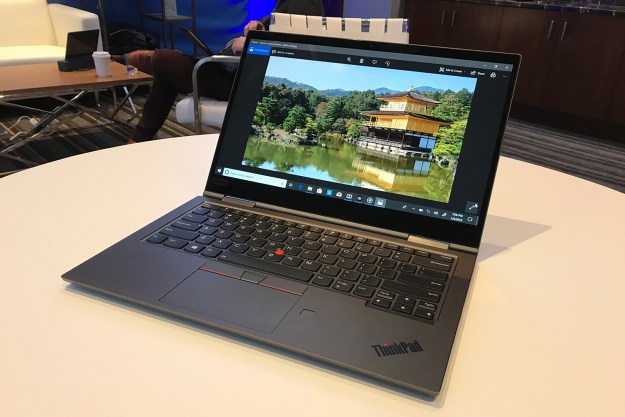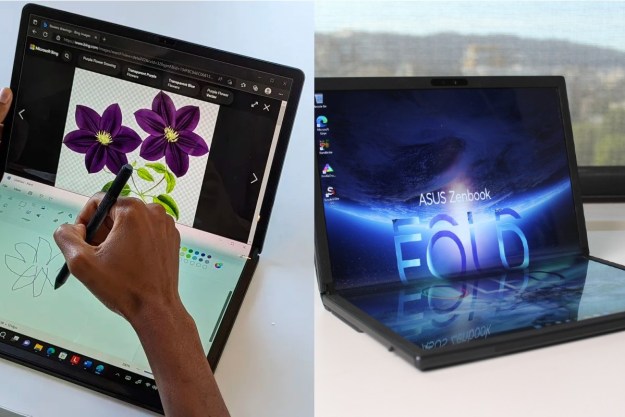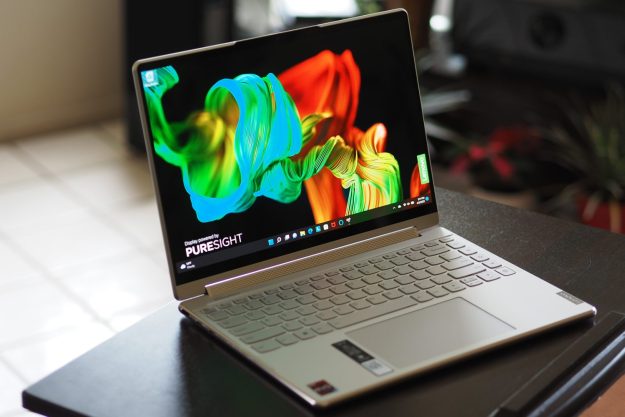
“The new ThinkPad X1 Yoga is aluminum and better for it.”
- Thin, light for its size
- Keyboard feels great
- Beautiful optional HDR display
- Aluminum chassis is very robust
- Look doesn’t excite
- Still a bit large for a 2-in-1
One does not simply change a ThinkPad. Lenovo’s hugely successful business line, bought from IBM thirteen years ago, has a cult following of users with specific needs. Even the slightest alteration can cause controversy.
More from CES 2019
- One of the coolest things at CES 2019 is a block of wood
- Sennheiser says you have to hear its new Ambeo soundbar to believe it
- Razer Raptor 27 hands-on review
- All CES 2019 coverage
Lenovo’s newest ThinkPad X1 Yoga, now on its fourth generation, is a prime example. It has an aluminum chassis. Other brands, including Lenovo’s IdeaPad line, have used aluminum for over a decade. Yet, Lenovo is guarded about its first aluminum ThinkPad, worried that fans of the brand – who are used to magnesium alloy or carbon fiber – will reject it.
Luckily, there’s no reason for concern.
There’s a reason everyone else uses aluminum
I’ll address the aluminum elephant first.
Modern ThinkPads are durable machines, but they have a problem. They don’t always feel that way. Both magnesium alloy and carbon fiber are light, and what’s light often feels fragile. The grippy texture that covers most ThinkPads doesn’t help. It keeps the system in your hand, but it feels like inexpensive plastic.
The aluminum X1 Yoga feels durable and robust yet, unlike many ThinkPads, looks luxurious as well.
It’s an issue we’ve complained about in the past. ThinkPads are not inexpensive, and while geeks in the know might appreciate the technology that makes them robust, most people will lean towards a laptop that seems more robust. That’s the Dell XPS 15 or 13, not the X1 Extreme or ThinkPad T480s.
The aluminum X1 Yoga feels durable and robust yet, unlike many ThinkPads, looks luxurious as well. No one will mistake it for an inexpensive laptop. Though, the design is a bit safe. Lenovo has stuck with a conservative style that won’t offend, but it also doesn’t make a statement.
The recipe has changed, but the baker is the same
Lenovo says the aluminum chassis had another benefit. Strength. It allowed for a stiffer chassis and that, in turn, helped the company shave the bezels. The X1 Yoga still has a 14-inch display, but it’s now about a half-inch smaller than the previous model in width and depth. It’s also a tenth of an inch thinner and a few grams lighter, though those changes are almost unnoticeable.
First, the bad news. While smaller than before, the X1 Yoga still isn’t a good tablet. It’s too heavy and too large to be used as a tablet for long. The versatility of its touchscreen and 360-degree hinge can be useful, but if you want to flip around your screen and carry a Windows 2-in-1 like an iPad, look elsewhere.

That leads to the good news. This is a very, very good PC that nails the fundamentals. It has a great keyboard with lovely key travel, a large touchpad, a trackpointer (for those inclined to use it), and several great display options including a 1440p touchscreen with
This is a very, very good PC that nails the fundamentals.
The port selection also remains solid. The X1 Yoga is thin, yet still includes two USB-A ports and two Thunderbolt 3 / USB-C ports, along with a 3.5mm headphone jack.
Surprisingly, the speakers have improved drastically. The X1 Yoga now has a four-speaker system that includes user-facing tweeters with small woofers underneath. This enabled Dolby Atmos support and, in our brief listen, made for a much richer experience. It’s still a laptop, but you won’t feel deep regret if you forget your
Much ado about nothing?
The Lenovo ThinkPad X1 Yoga is now aluminum. It’s a change, arguably a big one. Yet, that’s not how we felt when we used the 2-in-1.
The X1 Yoga has, since its introduction, served a specific niche of professional user who needs a seriously capable laptop but also wants to the benefits of 2-in-1 versatility. It’s always served that niche well, and the X1 Yoga doesn’t change the formula despite the switch of materials.
On the contrary, the fourth-generation model feels like a simple, robust, and pleasant upgrade. It’s smaller and feels more luxurious, yet retains the functional perks that define the device.
Yes, it’s aluminum. It’s also the best X1 Yoga yet.
Lenovo says the ThinkPad X1 Yoga 4th-gen will be available in June 2019 starting at $1,930.
Editors' Recommendations
- Best Lenovo laptop deals: Save on Yoga and ThinkPad laptops
- This tiny ThinkPad can’t quite keep up with the MacBook Air M2
- Why the latest ThinkPad X1 Yoga Gen 8 isn’t worth the upgrade
- The ThinkPad X1 laptop line embraces recycled magnesium and aluminum
- Microsoft Surface Pro 9 vs. Lenovo IdeaPad Duet 5i: which 2-in-1 is best?






